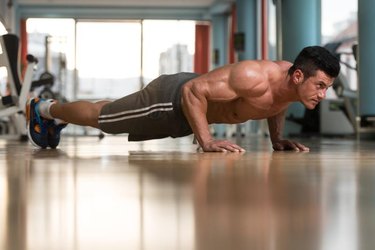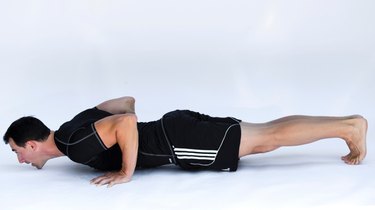If your goals include getting stronger and staying injury free, the rotator cuff, located at the shoulder, is a group of muscles you need to strengthen. The rotator cuff is a group of muscles (the supraspinatus, infraspinatus, subscapularis and teres minor muscles) that has become well-known for being at risk for injury and has been the cause of pain for two-thirds of shoulder pain issues according to American Family Physician in 2011.
Although it's labeled as a major source of shoulder pain, the rotator cuff is an integral component for health and performance, especially for active individuals and those who rely on their upper extremities to perform high intensity movements.
Video of the Day
Video of the Day
For these reasons, performing exercises that can help strengthen the rotator cuff, including the push-up, is a must.
Whether the goal is rehabilitation, injury prevention or to increase your strength and overall fitness, the push-up is an exercise that can easily be modified and included in your current fitness routine.
Function of the Rotator Cuff
While exercises such as internal and external rotations, resistance band work and reactive stability work are essential for rehab and to help us become familiar with how the rotator cuff should perform, they are not the "functional" movements that you'll experience in your life on a regular basis.
Read more: Physical Therapy Exercises For the Upper Arm
The function of the rotator cuff is not simply rotation of the upper arm, but more importantly, it combats the forces of other larger muscles such as the lats, pecs and deltoids to keep the joint in a good position.
When the rotator cuff is not working properly, or is not strong enough, the upper arm bone is likely to travel around or pop out of the socket, compromising the structures of the joint, which includes the rotator cuff.
So the rotator cuff must be trained in "functional patterns" that require it to stabilize the head of the humerus during more complex movements. The push-up helps you do this.
Progression and Regression
Whether the goal is rehabilitation, injury prevention or to increase your strength and overall fitness, the push-up is an exercise that can easily be modified and included in your current fitness routine.
The best way to change the intensity of the push-up is to adjust the position of your hands. To lessen the challenge, place your hands to a box, bench or stair. As you become stronger, work your hands lower until you eventually are pushing yourself up from level ground.
From there you can increase the challenge of the push-up by removing a point of stability such as a foot or hand, add some resistance such as a band or perform a more dynamic push-up variation such as a Spiderman push-up, in which you pull one knee to your triceps as you bend the elbows to lower down.
It's All About the Technique
If you don't get the basic form right, it doesn't matter which variation of a push-up you perform. Ensure that you keep certain form considerations in mind so you are performing the push-up to help strengthen the rotator cuff rather than compromise it.
Read more: Proper Push-Up Technique
Arm Position
Keep the position of the arms roughly 45 degrees to the body. If they go higher than than, the space in the shoulder joint is closed down and the rotator cuff is not in an optimal position to perform its job and therefore become stronger.
Also consider the position of the arm at the bottom of the push-up; don't allow the elbows to pass too far behind the body, as this increases the likelihood of the head of the humerus gliding or "popping" forward in the joint. Try to keep the upper arm in line with the torso at the bottom of the push-up.
Shoulder Blade Position
The shoulder blades want to move as a unit and stay flush to the back. So, as you descend into the push-up, think about tipping the shoulder blades back as you bring them together in a slow and controlled manner.
A cue that has become common in the fitness industry is to "pinch your shoulders together before you descend into the push-up." While this cue means well, as you don't want your shoulder blades staying to the sides of the back, you also don't want to pinch your shoulder blades together before you get to the bottom of the push-up. When you do this, you're not allowing your shoulder blades and joints to move appropriately, limiting the function and strengthening of the rotator cuff.

